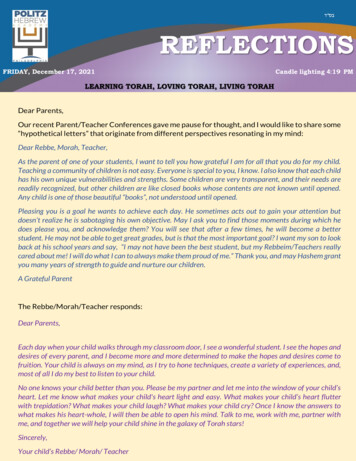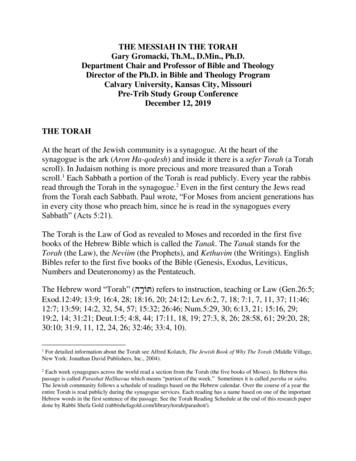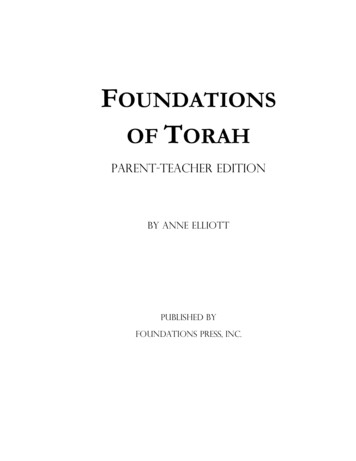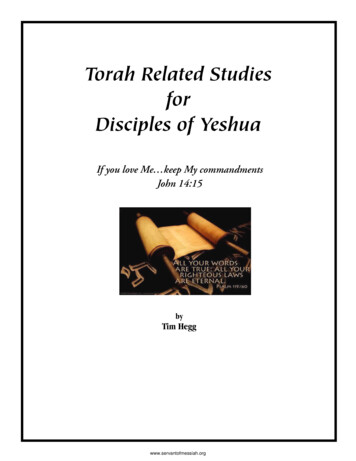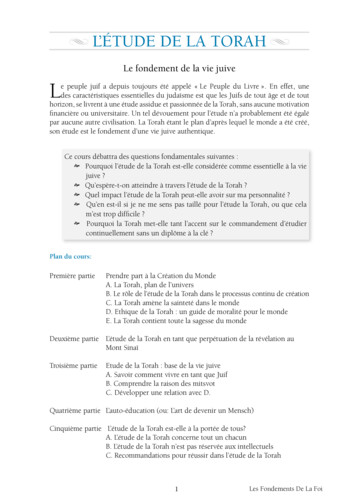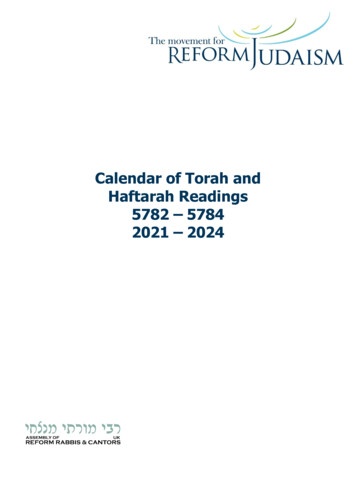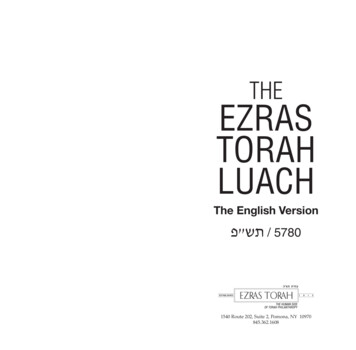
Transcription
THEEZRAS TORAH LUACHEZRASTORAHLUACH תש"פ / 5780THEThe English Version תש"פ / 5780 עזרת תורה עזרת תורה 1540 Route 202, Suite 2, Pomona, NY 10970845.362.16081540 Route 202, Suite 2, Pomona, NY 10970845.362.1608
Ezras Torah ׳ s sourcesof income:1. Generous individual donors.2. Shul and Yeshiva appeals, particularly fromthose held on Parshas Shekolim.3. Collections and appeals made at summerand winter resorts, hotels, and bungalowcolonies.4. Monies received from local and nationalJewish Federations.5. Wills and bequests.6. Ladies Auxiliaries of Ezras Torah.7. Special events such as Parlor Meetings,Breakfasts, Melava Malkas.8. Monies collected from the Ezras Torah Pushkas. A Pushka can be obtained by writing orcalling the Ezras Torah office.9. Monies that are obtained by the sale of thevarious Ezras Torah calendars — the Hebrew Wall and Pocket Calendars, and theEnglish Pocket Calendar.The vast majority of the monies that Ezras Torahcollects for distribution is obtained throughthe hard work of volunteers in America andthroughout the world.1
A Contribution ToEzras Torah Is a Charitable ActThat Encompasses Every Aspectof Tzedakkah and Chesed.And happy are those who participate.With the passings of the Gaon HaRavYosef Eliyahu Henkin, the Gaon HaRavNaftali Zvi Yehuda Riff, the Gaon HaRavMoshe Feinstein, and the Gaon HaRavDovid Lifshitz, and the Gaon HaRavMenachem Gettinger, זצ"ל , who all devotedso much brilliance, energy, and effort toEzras Torah, it is incumbent upon all of usto lend a hand and to participate in EzrasTorah’s activities.In these days of Divine Compassion andof our prayers for forgiveness, may we alldeserve to see the salvation of all Israel, andmay the Al-Mighty fulfill the requests of ourhearts for good; for us and for all Israel.THE ADMINISTRATIONOF EZRAS TORAHHARAV YISRAEL GETTINGERPresident2
A Declaration From Ezras TorahTo Our Brethren, The People OfIsrael, Wherever They MaySojourn:With Warm Wishes For Peace And WithBlessings For A Good Year.This holy organization, Ezras Torah, fromthe time of its founding in 5675 (1915) untilthe present time; throughout its history ofmore than three quarters of a century, hasalways maintained the highest standards in theadministration of vital aid and succor to needyTorah scholars, Rabbis, Gaonim and Tzaddikim,and widows and orphans.During the course of this time, beginningwith World War One, the Jewish peopleexperienced many years of incredible suffering,hardship, and tragic persecution. Ezras Torahmaintained a constant vigil in order to help easethe misery of those who were suffering, to theextent of its ability.And now, with the turmoil and upheaval thatexists throughout the world, the administrationof Ezras Torah is hard pressed to help find thesolutions for the following problems:a) The terrible economy of our Holy Land, andthe rampant inflation that worsens from dayto day.3
b) The very painful housing shortage thatexists in our Holy Land. In this matter wehave invested tremendous effort to offervital housing aid.c) New immigrants, in particular those fromRussia, even when they escape to somedegree of tranquility, must still receivetremendous support during their initialperiod of adjustment.d) Modest families of the highest moral andreligious calibre turn to us with requestsof a type that we receive from all over theworld. They are not seeking handouts,rather, help of the most honorablekind. Their eyes are turned to our holyorganization and they look to us for sometype of support. The administration of EzrasTorah has exerted itself above and beyondits capacity in order to increase the level ofaid to all those who need it. In doing so wehave sunken into debt well over our heads.Besides all of the special situations, EzrasTorah has not abandoned its constant ongoingphilanthropy: To the young married men of more than600 kollels in the Land of Israel who receivefinancial aid at Yom Tov time. Respectable financial marriage grants toyoung couples.4
Financial grants to the ill and to familieswho are in great duress because of someone’sillness. Vital financial aid to observant familieswho suddenly find themselves in financial crisis. A very special source of Bracha are thePerpetual interest-Free Loan Funds that EzrasTorah runs in our Holy Land, that were foundedat the insistence of the Gaon HaRav YosefEliyahu Henkin, זצ"ל More than one thousand of these loanfunds exist today. These funds are the fruitsof the generosity of cherished benefactorswhose desire is to aid the needy in the mosthonorable manner possible, while at the sametime perpetuating the memories of their mostcherished relatives or friends.Many thousands of individuals and familieshave received aid from these loan funds, whilehundreds of urgent requests for loans arewaiting their turn. To our great distress we donot always have enough funds available to meetall requests.Therefore we turn to cherished contributorsin all parts of the world, to send in their largeand generous donations. We also seek peoplewho wish to establish new Perpetual InterestFree Loan Funds. All those who can afford to doso, should endeavor to take part in a Mitzvah ofsuch great magnitude.5
INTRODUCTIONThe original Ezras Torah Walland Pocket Calendars have becomean extremely popular and almostindispensable tool for thousands ofRabbonim and Gabbaim, for whom thework was intended. Each entry to thisnow classic work was produced withpainstaking care and devotion. Theoriginal Luach was intended as an onthe-spot aid, not as a replacement for athorough familiarity with the Halachicsources.In truth, this is a translation of awork that was never intended for thegeneral public. However, because weare living in a time of an incrediblethirst and desire for Torah knowledgeon the part of thousands of people whoare unable to read the original sources,the decision was made to translate thepocket calendar with the inclusion ofsome explanatory remarks.Any errors in the Luach should beconsidered as errors in translation.The Translators6
THE ARRANGEMENTOF THE YEAR5780 from the creation of the world.Symbol is בש"ה : Rosh HaShanah falls outon Monday (the second day of the week;Cheshvan and Kislev are both 30 days( ;)שלמים Pesach falls out on Thursday(the fifth day of the week). The year is aregular year consisting of 355 days andcontaining 50 Shabosos. It is the 4th yearof the 305th minor (19 year) Lunar cycleand the 12th year of the 207th major (28year) Solar cycle. It is the fifth year of theShemitah cycle (seven years) accordingto the computation of the Gaonim and asis accepted as the custom in the Land ofIsrael.The beginning of each of the fourperiods that mark the different seasonalskies are as follows:Tekufas Tishrei: 9 Tishrei, Oct. 7 at 9:00P.M.Tekufas Teves: 10 Teves, Jan. 7, at 4:30A.M.Tekufas Nisan: 13 Nissan, Apr. 7 at12:00 noon.Tekufas Tamuz: 15 Tamuz, July 7, at7:30 P.M.7
THE TIMES OFTHE NEW MOON מולדות The Molads are announced by theGabbai at the time of the Blessing of theNew Month, which takes place on theShabbos before Rosh Chodesh (with theexception of the month of Tishrei whoseMolad is not announced). The time forthe Molad of each month is traditionallyexpressed in the days, minutes, andChalokim after the hour. (A Cheilek, thesmallest traditional measurement ofthe time, is 1/1080 of an hour, or 1/18of a minute, which amounts to a littlemore than three seconds.) Thus, thetraditional way of announcing theMolad for MarCheshvan would be toannounce: “The Molad for MarCheshvanwill be Monday, Oct. 28, 6:34 PM and6 Chalokim.” (The times of Molad is inIsrael, see page 67).TISHREI: – Sunday, Sep. 29, 5:50 AMand 5 Chalokim.MARCHESHVAN: – Monday, Oct. 286:34 PM and 6 Chalokim.KISLEV: – Wednesday, Nov. 27, 7:18AM and 7 Chalokim.TEVES: – Thursday, Dec. 26, 8:02 PMand 8 Chalokim.8
SHEVAT: – Saturday, Jan. 25, 8:46 AMand 9 Chalokim.ADAR: – Sunday, Feb. 23, 9:30 PMand 10 Chalokim.NISAN: – Tuesday, March 24, 10:14AM and 11 Chalokim.IYAR: – Wednesday, April 22, 10:58PM and 12 Chalokim.SIVAN: – Friday, May 22, 11:42 AMand 13 Chalokim.TAMUZ: – Sunday, June 21, 12:26 AMand 14 Chalokim.AV: – Monday, July 20, 1:10 PM. and15 Chalokim.ELUL: – Wednesday, August 19, 1:54AM and 16 Chalokim.IMPORTANT NOTECandle lighting listings for Shabbos andYom Tov are 20 minutes before sunsetand all time listings inside and at theend of the Luach are Standard Time. ForDaylight Savings Time add 1 hour.9
תשרי TISHREI 5780 תחל שנה וברכותיה May the year and its blessings beginMolad Tishrei: Sunday, Sep. 29, 5:50 AM and 5 Chalokim10
ערב ראש השנה EREV ROSH HASHANAHSUNDAY, SEPT. 29, 29 ELUL(Some are accustomed to fast untilnoon.) We begin saying the many Selichosof Erev Rosh HaShanah that include " זכור "ברית , before the pre-dawn sky begins tobrighten; Nefilas Apayim during Selichosbut not during morning or afternoonprayers; We say למנצח . One who arosebefore dawn and at that time washed hishands in the prescribed manner, threetimes alternately on each hand, mustwash them again three times after dawn(see Mishne Brurah on Orach Chaim 4:14).We do not sound the Shofar at all duringthe day to make a distinction between theShofar of Elul and the obligatory Shofar ofRosh HaShanah; התרת נדרים .[Harav Yosef Eliyahu Henkin זצ"ל noted:The Chazzan and the Baal T’kiah (theone who sounds the shofar) must be Torahobservant, pious individuals who understandthe meaning of what they are saying anddoing. The melodies used should not distortor interfere with the words of the prayers.Willful and blatant transgressors may notbe permitted to represent the congregation.During the rest of the year, too, and especially,during the Ten Days of Repentance, suchpeople should not lead public prayer even ifthey are mourners or have a Yahrzeit – fortheir prayers are of no benefit to the deceased.]11
We take haircuts and bathe in honorof the approaching holiday. Immersionin a Mikveh, not before an hour beforemidday, is appropriate so that we mayenter the Day of Judgement in a state ofholiness and purity. הדלקת נרות / CANDLE-LIGHTINGThe Brachos over candle-lightingare " "להדליק נר של יום טוב and " "שהחיינו . Itis a good habit to give Tzedakah beforecandle-lighting for Shabbos and Yom Tov(an Ezras Torah pushka may be obtainedfor this purpose). It is proper that at thistime a woman pray for sons who will beTorah luminaries (Mishne Brurah 263:2). א׳ דראש השנה FIRST DAYROSH HASHANAHSUNDAY EVENING, 1 TISHREIOne comes to Shul on Sundayafternoon, the eve of Rosh HaShanahwith reverence and trepidation for theapproaching Divine Judgement. Duringthe Ten Days of Repentance it is properfor everyone to pray at the proper timewith a Minyan, even if one is not usuallyso conscientious. Also, in other areasof religious observance one shouldadopt pieties not ordinarily observedthe rest of the year, during these tendays, beginning with Rosh HaShanah12
and ending with Yom Kippur, for this isa special time for repentance and Divinemercy. One should be particularly carefulthroughout the entire year to respondwith ( אמן Amen) in the correct manner.For example, one should not answer אמן in a hasty fashion before the Chazzancompletes the entirety of the Bracha.(See Orach Chaim 124 for additional lawsregarding the response of אמן . Note thatthe prohibition against speaking duringthe Chazzan’s repetition of the ShemonahEsrei is a very serious one.)“Rabbeinu Asher (the Rosh) wrotethat during the Ten Days of Repentance,one should read the Letter of Repentanceby Rabbeinu Yonah. The Ari ז"ל wrotethat one is obligated to study Mussar(the study of personal behavior)works throughout the entire year. TheVilna Gaon expressed the same ideathroughout his commentary to Mishleiand it is related in the work Maaseh Rav(which details the personal habits of theVilna Gaon) that this was the customof the Gaon. At the very least, duringthese days, everyone should attempt tofollow the custom of the Zohar whichstates that each night before one goesto sleep, one should repent, lament hissins, and examine his conduct withscrutiny. See the work Yaaros Dvash (byR. Yonoson Eibshitz) volume 1, DrushI, wherein it states that the seven days13
between Rosh HaShanah and Yom Kippurare representative of each of the daysof the week throughout the entire year.Thus, on that Sunday one does Teshuvahfor every Sunday of the year, on Monday,for every Monday, etc.” (Mishne Brurah603:2). ערבית / MAARIVFollowing the Machzor we say ברכו .; תקעו ;ופרוש .; followed by Half-Kaddish(we say ( לעילא לעילא מכל ברכתא or )ולעילא inevery Kaddish until after Yom Kippur). Inthe Shemonah Esrei for Rosh HaShanah weadd זכרנו , מי כמוך , וכתוב and ( בספר duringthe week המלך המשפט is recited) (if any ofthese were omitted one does not haveto repeat the Shemonah Esrei). The thirdBracha is ( המלך הקדוש if one says the usual ל הקדוש - הא and did not immediatelycorrect it, the Shemonah Esrei must berepeated over again. This holds truethroughout the Ten Days until after YomKippur). The conclusion of the final Brachaafter " בספר חיים ." is the usual: " המברך את ( "עמו ישראל בשלום many conclude with" )"עושה השלום . (according to Nusach Sefardthe congregation says לדוד מזמור after theShemonah Esrei); Kaddish Tiskabel [ ]תתקבל (the conclusion of every Kaddish duringthese ten days is " "עושה השלום etc); Kiddushof Rosh HaShanah with לדוד ד׳ ;עלינו ;שהחיינו ;אורי Mourner’s Kaddish אדון עולם .The Shulchan Aurch (Orach Chaim:132) states: “We recite at the end of each14
service עלינו לשבח in a standing position.One should be careful to say this prayerwith proper intent.” The Mishne Brurah(subparagraph 8) makes the followingcomment: “One should say עלינו withgreat awe and trepidation for the entireHeavenly Host is listening. The HolyOne, Blessed be He, stands with hisHeavenly contingent and they respond,‘Happy are the people who are in such acase, happy are the people whose G-d isthe L-rd.’”On the first night, after services webless each other with: " לשנה טובה תכתב “( "ותחתם May you be inscribed andsealed for a good year”) (according to theVilna Gaon we do not say " ‘( "ותחתם andsealed’) on Rosh HaShanah).At home, Kiddush, as above; ritualwashing of hands, followed by the Brachos על נטילת ידים and המוציא . To symbolizea sweet year we dip the challah in honeybefore eating it. We also dip a piece of apple into honey and eat it after making theBracha בורא פרי העץ . We then say, “May itbe Your will our G-D and G-D of our fathers that You renew for us a good, sweetyear.” Other symbolic foods are eatensuch as a bit of meat of a ram’s head, orof the head of a fish or fowl, followed bystatements such as, “May it be Your willthat we be raised high and proud like thehead and not lowly like the tail.” We eatgrated carrots (the Yiddish word for car15
rots ‘Mehren’ can be translated as multiplying’) and say, “May it be Your will thatwe be fruitful and multiply” and “Mayit be Your will that our merits increase.”(The Talmud states that it is proper toeat a variety of symbolic foods on thenight of Rosh HaShanah. The Sefardim stilleat many of the symbolic foods that arementioned in the Talmud). “All of thesesymbolic acts are performed with the intent of exhibiting propitious signs of agood new year. It is, therefore, obviousthat one should strive to refrain from anger during this time period. This is notmerely in order to avoid the very seriousprohibition against anger, but also in order to usher in the new year in a properstate of mind. One should maintain acheerful disposition and have a securetrust in HaShem, while aspiring to sincererepentance and good deeds.” [From theChayei Adam quoted by the Mishne Brurah: 583: subparagraph 5].MONDAY MORNING, SEPT. 30 שחרית / SHACHRIS(One should not alter the specialtraditional melodies associated with RoshHaShanah and Yom Kippur). The Chazzanwears a Kittel under his Tallis (somehave the custom that all the congregantswear the Kittel on Rosh HaShanah). Thecustom is to say the ( שיר היחוד for the2nd day of the week); ;אנעים זמירות the16
Psalm of the Day and לדוד אורי , followedby Mourner’s Kaddish and ;אדון עולם theregular morning Brachos, followed by thecustomary morning order: ;פסוקי דזמרה ;ישתבח ;המלך ;נשמת Half-Kaddish ( שיר המעלות ממעמקים is said between ישתבח andthe Half-Kaddish); ברכת יוצר ;ברכו .; (withthe customary additions – Piyutim forRosh HaShanah); [ ;קריאת שמע ;אהבה רבה RavHenkin noted that according to the Talmud,the Chazzan should say the entire text of theBrachos of the Shema, both morning andevening, in an audible voice (as is the customof the Sefardim). The Ashkenazim arelenient in this matter and have the Chazzansay only part of the Brachos audibly; theessence being the beginning and the endof each Bracha. A Chazzan who says theending of גאל ישראל in an inaudible voice,is violating the Talmud’s ruling. Thereforeit is a Mitzvah to correct this matter, andto insist that the Chazzan begin יוצר אור and conclude גאל ישראל in an audible voicethe entire year]; Shemonah Esrei of RoshHaShanah. חזרת הש"ץ / CHAZZAN’S REPETITIONThe customary Piyutim are said; אבינו מלכנו after the Shemonah Esrei; KaddishTiskabel; " ( "אין כמוך Nusach Sefard: " אתה ;)"הראת open Aron; י"ג מדות followed by thespecial רבונו של עולם for Rosh HaShanah; wetake out two Sifrei Torah; שמע ;בריך שמיה על הכל ;גדלו ;קדוש ונורא ;אחד ;ישראל .17
קריאת התורה / TORAH READING ;ויעזר ויגן there are five Aliyahs inParshas Vayeira (Genesis: 21:1-34). Thesecond Sefer Torah is placed next to thefirst and Half-Kaddish is said. The Maftirreads from the second Sefer Torah inParshas Pinchas (Numbers 29:1-6). TheHaftorah is read from Samuel I: 1:1-2:10.In the Brachos after the Haftorah, we say" "יום הזכרון הזה and we conclude: " מקדש "ישראל ויום הזכרון . After the reading fromthe Torah we blow the Shofar. תקיעת שופר / SOUNDING THE SHOFAR(The custom is to appoint a מקריא (prompter), who stands by the side of theBaal T’kiah and calls out the proper orderof תקיעות . The prompter must be a Torahscholar who is totally familiar with thelaws of the Shofar. Before sounding theShofar, we recite " ( "למנצח Psalm 47) seventimes, followed by the verses whose firstletters spell out " “ "קרע שטן destroy Satan.”The Baal T’kiah makes the Brachos: ," לשמוע "קול שופר and " "שהחיינו . He must bear inmind that he is making the Brachos andsounding the Shofar on behalf of all thosewho are listening.The Baal T’kiah blows three sets eachof תשר"ת , תש"ת , and תר"ת . The promptermust listen carefully for any possibledeviation from the Halacha, which wouldrequire a repetition of any of the sounds.One may not talk during the first18
thirty sounds, and even afterwards oneshould not talk until the conclusion ofall one hundred sounds at the end ofservices. After these first thirty blasts wesay: אשרי העם יודעי תרועה .; ;אשרי יושבי ביתך we return the Sifrei Torah to the ark. [RavHenkin noted that one may not eat beforehearing the Shofar sounded. However if onefeels weak, he may make Kiddush and tastesome food immediately after the first thirtyblasts – the ]תקיעות דמיושב . מוסף / MUSSAFThe Chazzan says ;הנני Half-Kaddish;in the Shemonah Esrei of Mussaf we say" "ובחדש השביעי . (Nusach Sefard calls for theblowing of תשר"ת , תש"ת and תר"ת after מלכיות , זכרונות , and שופרות during the silentMussaf as well as during the Chazzan’sRepetition). חזרת הש"ץ / CHAZZAN’S REPETITIONFollowing our custom, we blow תשר"ת , תש"ת , and תר"ת after מלכיות , זכרונות ,and שופרות , and we say after each groupof Shofar blasts, " "היום הרת עולם and " ארשת "שפתינו . נשיאת כפים / THE PRIESTLY BLESSINGThe Kohanim wash their hands untilthe wrist before the Chazzan reaches רצה .The custom is for a Levi (if there is noLevi, then a first-born) to pour the wateron the Kohen's hands.At רצה the Kohanim begin to mount19
the platform and the congregation says" "ותערב . After the Chazzan says " נאה "להודות he says " אלקינו ואלקי אבותינו ברכנו ."in a whisper. When he reaches theword " "כהנים he says it in a loud voiceto which the congregation responds: " עם ;"קדושך כאמור after which the Kohanimpronounce the Bracha: " אשר קדשנו בקדושתו של אהרן .". The Chazzan prompts theKohanim with the Priestly Blessing,word by word, and they repeat eachword after him. The congregation saysthe prayers found in the Machzor. [RavHenkin noted that in some congregations theKohanim repeat the final word of each ofthe verses that compose the Bracha ( וישמרך , ויחנך , )שלו׳ , immediately after the Chazzan,who then pauses to allow the congregationto recite the above -mentioned prayers. Thisis done so as to avoid the possible problem ofan undue interruption within the Blessing,and to leave no room for error on the part ofthe Kohanim. The prayers that are foundin the Machzor are then recited by thecongregation afterwards.] Kaddish Tiskabel;(before the Chazzan says the word " "תתקבל the Baal T'kiah sounds תשר"ת , תש"ת , and תר"ת which consist of ten sounds); אין ;עלינו ;כאלקינו Mourner's Kaddish; thenwe blow an additional thirty sounds tomake a total of one hundred sounds.(Those who followed Nusach Sefard andalready blew thirty sounds during thesilent Mussaf don't blow now). If the20
Daily Psalm or לדוד אורי were omittedbefore services, they should be recitednow; אדון עולם .At home, Kiddush over wine: תקעו בחדש followed by בורא פרי הגפן . We eat atypical Yom Tov meal, followed by BirkasHaMazon, which includes יעלה ויבא .Weshould attempt to remain awake theentire day of Rosh HaShanah, spendingthe day in the study of Torah and in therecitation of Tehillim. מנחה / MINCHA ;ובא לציון ;אשרי Half-Kaddish; ShemonahEsrei of Rosh HaShanah (with all ofthe appropriate additions: זכרנו , etc.);according to Nusach Ashkenaz, ;שלום רב theChazzan’s Repetition; ;אבינו מלכנו KaddishTiskabel; ;עלינו Mourner’s Kaddish. Theprevailing custom is to go to a river (orother body of water) to say Tashlich; someadd the additional prayers and requeststhat are found in the Machzor. If one didnot say Tashlich on Rosh Hashanah, hemay do so throughout the Ten Days ofRepentance. ב׳ דראש השנה SECOND DAYROSH HASHANAHMONDAY NIGHT, SEPT. 30, 2 TISHREI(We wait seventy-two minutes aftersunset before lighting candles. The samelength of time applies for all preparations21
for the second day. In extenuating circumstances, an hour’s wait is sufficient.)The Brachos over the candle-lighting are להדליק נר של יום טוב and ( שהחיינו it is properfor women, to wear a new garment ordisplay a new fruit at candle-lighting sothat the שהחיינו applies to this as well. Thefruit may only be eaten after Kiddush). ערבית / MAARIV ;ברכו . ;ופרוש . תקעו .; followed byHalf-Kaddish; the Shemonah Esrei of RoshHaShanah (with all of the appropriateadditions: , זכרנו etc.); (according toNusach Sefard the congregation says לדוד מזמור after the Shemonah Esrei); KaddishTiskabel; Kiddush; ;לדוד אורי ;עלינו Kaddish; ( אדון עולם all as on the previous day).Kiddush at home. קידוש / KIDDUSHOn the second night we bring tothe table a new fruit or we wear a newgarment so that the Bracha שהחיינו thatwe recite at the end of Kiddush applies tothese as well. The fruit may only be eatenafter Kiddush. (If one forgot to prepare anew fruit or garment he may still makethe )שהחיינו .TUESDAY MORNING, OCT. 1 שחרית ומוסף / SHACHRIS and MUSSAFAs on the previous day, we commencewith the ( שיר היחוד for the third day of theweek); ;אנעים זמירות the Psalm of the Day22
and ;לדוד אורי followed by Kaddish and ;אדון עולם the regular morning Brachos,followed by the customary morningorder ;ישתבח ;המלך ;נשמת ;פסוקי דזמרה Half-Kaddish ( שיר המעלות ממעמקים is saidbetween ישתבח and the Half-Kaddish). ;ברכו ברכת יוצר .; (with the customary additions– Piyutim for the Second Day of RoshHaShanah); ;אהבה רבה Shema; ShemonahEsrei; repetition by the Chazzan; ;אבינו מלכנו Kaddish Tiskabel; " ; "אין כמוך open Aron; י"ג ;מדות followed by the special רבונו של עולם for Rosh HaShanah; We take out two SifreiTorah; ;קדוש ונורא ;אחד ;שמע ישראל ;בריך שמיה ויעזר ויגן ;על הכל ;גדלו . There are five Aliyahsin the first Sefer Torah. We read againfrom Parshas Vayeira continuing fromGenesis 22:1-24 (from " "ויהי אחר הדברים until the end of the Parsha); Half-Kaddish;in the second Sefer Torah we read thesame Maftir as yesterday: Numbers 29:16 (Parshas Pinchas ;)ובחדש השביעי Haftorahfrom Jeremiah 31:1-19; Brachos after theHaftorah; Shofar blowing; Mussaf; all aswas done yesterday. It is advisable thaton the second day of Rosh HaShanah theBaal T’kiah wear a new garment thatrequires a שהחיינו in the manner of lastnight’s Kiddush. מנחה / MINCHA ;ובא לציון ;אשרי Half-Kaddish; ShemonahEsrei of Rosh HaShanah; according toNusach Ashkenaz – ;שלום רב the Chazzan’s23
Repetition; ;אבינו מלכנו Kaddish Tiskabel; ;עלינו Mourner’s Kaddish. מוצאי ראש השנה THE NIGHT FOLLOWINGROSH HASHANAH(It is proper to wait 72 minutes after sunset [under extenuating circumstances, 60 minutes] before makingHavdalah and doing work. This appliesto every night that follows Shabbos orYom Tov). ערבית / MAARIVWe begin " ;ברכו ;"והוא רחום weekdayShemonah Esrei: " המלך" ;"מי כמוך" ;"זכרנו ;"הקדוש the additions in ShemonahEsrei; apply throughout the Ten Daysof Repentance. (See our instructionsfor the first night of Rosh HaShanahconcerning the omission of theseadditions); " "המלך המשפט" ;"אתה חוננתנו (we add המלך המשפט during everyweekday Shemonah Esrei of the Ten Daysof Repentance. If one omitted it he doesnot have to repeat the Shemonah Esrei.If one remembered that he omitted thewords המלך המשפט immediately at theconclusion of the Blessing, he shouldsay the words המלך המשפט then.); " ;"וכתוב " ;"בספר חיים Kaddish Tiskabel; Havdalah –No candle or spices – only the Brachos" "בורא פרי הגפן and " ;לדוד אורי ;עלינו ;"המבדיל Mourner’s Kaddish.24
הבדלה / HAVDALAHHavdalah at home as in Shul.[Rav Henkin noted that the mostappropriate time to begin the morning prayersis in the following fashion: The introductoryBracha to "ברוך שאמר" ;פסוקי דזמרה should bebegun twenty minutes before sunrise, so thatthe Shema and its final Bracha " "גאל ישראל are completed by sunrise, and the ShemonahEsrei begins exactly at sunrise, in the fashionof the " – "ותיקין the ancient pietists whose livesrevolved around the performance of Mitzvosin the most exemplary fashion possible).]The earliest time that one may unquestionably put on Tefillin and recite the Shemonah Esrei is approximately one hour beforesunrise (this is the time when there is enoughnatural illumination to recognize a casualacquaintance from a distance of six to eightfeet). In extenuating circumstances, one mayput on Tefillin and daven 72 minutes beforesunrise. However, earlier than 72 minutesbefore sunrise, one cannot fulfill the Mitzvosof Tefillin, the morning Shema etc.] צום גדלי׳ FASt OF GEDALIAHWEDNESDAY, OCT. 2, 3 TISHREIThis is a Public Fast Day. Selichos aresaid before the regular morning servicethroughout the days between RoshHaShanah and Yom Kippur, except for25
Shabbos (one should attempt to begin theSelichos before the pre-dawn sky beginsto brighten); the regular morning service;in the Shemonah Esrei: זכרנו , מי כמוך , המלך הקדוש , וכתוב ;המלך המשפט and ( בספר allthese are repeated during the Chazzan’sRepetition of the Shemonah Esrei); theChazzan says עננו between גואל and ;רפאנו (If the Chazzan forgot to say עננו here; heshould add it during שומע תפילה as anindividual does at Mincha.); אבינו מלכנו (is said after the Chazzan’s Repetitionof the Shemonah Esrei at Shacharis andMincha throughout the Ten Days ofRepentance except after mincha ErevShabbos, Tachanun; Half-Kaddish; (somehave the custom of saying the י"ג מדות whenever we take out the Sifrei Torahthroughout the Ten Days of Repentance,except Shabbos); three Aliyahs in theusual reading for Public Fasts, " "ויחל in Parshas Ki Sisah (32:11-14, 34:1-10);Half-Kaddish; ;ובא לציון ;למנצח ;אשרי ;יהללו Kaddish Tiskabel; ;עלינו Psalm of the Day; ;לדוד אורי Mourner’s Kaddish. מנחה / MINCHA ;אשרי Half-Kaddish; we take out aSefer Torah (some say ;)י"ג מדות if thereare at least six people present who arefasting, we have three Aliyahs in " "ויחל as in the morning; [Rav Henkin noted thatthere are those who read " "ויחל even if thereare only three men present who are fasting.Those three men who are fasting are called to26
the Torah. This leniency applies only to thefour Fast Days mentioned by the Prophets(Tzom Gedaliah, the Tenth of Teves theSeventeenth of Tamuz, and Tisha B’Av). Itdoes not extend to Taanis Esther or to PublicFasts that are decreed by a Kehillah becauseof a state of emergency.] the third Aliyah isthe Maftir; no Half-Kaddish after the Torahis read. The Haftorah " "דרשו : Isaiah: 55:656:8, is the usual one for the afternoonsof Public Fasts (except for Yom Kippur);Brachos after the Haftorah until " מגן ;יהללו ;"דוד Half-Kaddish; Shemonah Esreiincluding זכרנו , מי כמוך , המלך הקדוש , המלך המשפט , עננו in " ;שים שלום ;וכתוב ;"שמע קולנו and בספר . חזרת הש"ץ / CHAZZAN’S REPETITIONAs in the morning the Chazzanadds all the special insertions of theRepentance, also saying עננו between גואל and רפאנו , and adding ברכת כהנים before ;אבינו מלכנו ;שים שלום Tachanun; KaddishTiskabel; ;עלינו Mourner’s Kaddish. שבת שובה SHABBOS SHUVAHFRIDAY AFTERNOON,OCT. 4, 5 TISHREI[Rav Henkin noted that in preparing forShabbos, one should be certain that all foodthat is to be kept warm, must be completelycooked before candle-lighting time. The27
possibility of permitting ( קידרא חייתא foodthat is totally raw to be placed on a coveredflame immediately before candle-lighting)that is discussed in the Talmud, should notbe used nowadays. If food is not completelycooked before Shabbos, there i
8. Monies collected from the Ezras Torah Push - kas. A Pushka can be obtained by writing or calling the Ezras Torah office. 9. Monies that are obtained by the sale of the various Ezras Torah calendars — the He-brew Wall and Pocket Calendars, and the English Pocket Calendar. The vast majority of the monies that Ezras Torah



